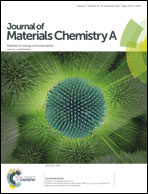Synergistically reinforced lithium storage performance of in situ chemically grown silicon@silicon oxide core–shell nanowires on three-dimensional conductive graphitic scaffolds†
Abstract
The silicon material is the most promising candidate for developing new-generation lithium-ion batteries with high energy and power output. However, there remains a significant challenge due to poor electrical conductivity and pulverization of the silicon based anode during cycles. Aiming to solve these problems, in this work we fabricate a novel 3D composite architecture made of a Si@SiOx core–shell nanowire array grown on a 3D graphitic foam (Si CNW–3D GF) substrate by a well-designed multiple-step approach. The prepared Si CNW–3D GF composite shows the integrated advantages for high-performance lithium ion batteries, including its light weight, open macroporosity, high conductivity, high Si NW loading, excellent flexibility as well as SiOx buffer layers. As a result, the Si CNW–3D GF composite exhibits excellent performance such as high reversible lithium storage capacity (3603 mA h g−1 at a current density of 840 mA g−1), excellent cycling performance (up to 100 cycles) and superior rate capability (2299 mA h g−1 at 4200 mA g−1 and 1206 mA h g−1 at 8400 mA g−1), which is 2 times that of the Si CNW electrode where Si CNWs were grown directly on a stainless steel current collector without the presence of 3D GF.


 Please wait while we load your content...
Please wait while we load your content...